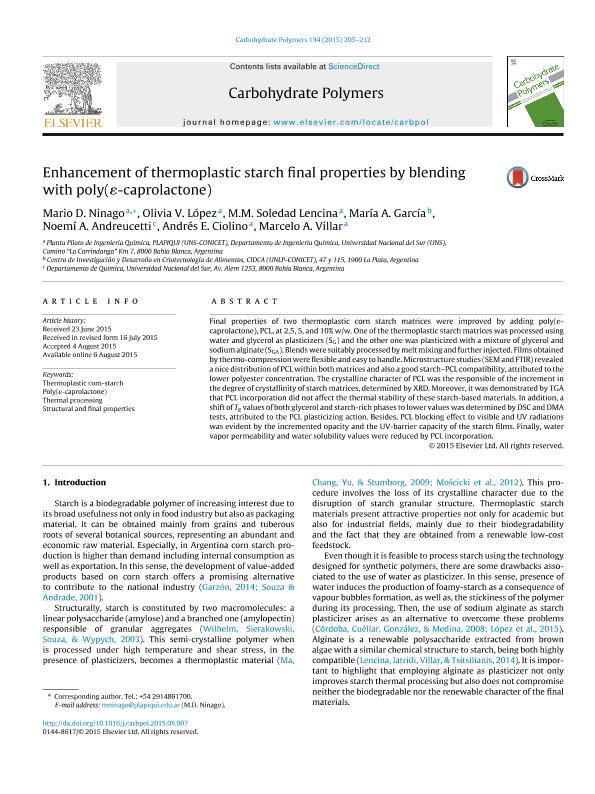Artículo
Enhancement of thermoplastic starch final properties by blending with poly(e- caprolactone)
Ninago, Mario Daniel ; Lopez, Olivia Valeria
; Lopez, Olivia Valeria ; Lencina, María Malvina Soledad
; Lencina, María Malvina Soledad ; Garcia, Maria Alejandra
; Garcia, Maria Alejandra ; Andreucetti, Noemi Amalia; Ciolino, Andrés Eduardo
; Andreucetti, Noemi Amalia; Ciolino, Andrés Eduardo ; Villar, Marcelo Armando
; Villar, Marcelo Armando
 ; Lopez, Olivia Valeria
; Lopez, Olivia Valeria ; Lencina, María Malvina Soledad
; Lencina, María Malvina Soledad ; Garcia, Maria Alejandra
; Garcia, Maria Alejandra ; Andreucetti, Noemi Amalia; Ciolino, Andrés Eduardo
; Andreucetti, Noemi Amalia; Ciolino, Andrés Eduardo ; Villar, Marcelo Armando
; Villar, Marcelo Armando
Fecha de publicación:
06/08/2015
Editorial:
Elsevier
Revista:
Carbohydrate Polymers
ISSN:
0144-8617
Idioma:
Inglés
Tipo de recurso:
Artículo publicado
Clasificación temática:
Resumen
Final properties of two thermoplastic corn starch matrices were improved by adding poly(-caprolactone), PCL, at 2.5, 5, and 10% w/w. One of the thermoplastic starch matrices was processed usingwater and glycerol as plasticizers (SG) and the other one was plasticized with a mixture of glycerol andsodium alginate (SGA). Blends were suitably processed by melt mixing and further injected. Films obtainedby thermo-compression were flexible and easy to handle. Microstructure studies (SEM and FTIR) revealeda nice distribution of PCL within both matrices and also a good starch?PCL compatibility, attributed to thelower polyester concentration. The crystalline character of PCL was the responsible of the increment inthe degree of crystallinity of starch matrices, determined by XRD. Moreover, it was demonstrated by TGAthat PCL incorporation did not affect the thermal stability of these starch-based materials. In addition, ashift of Tg values of both glycerol and starch-rich phases to lower values was determined by DSC and DMAtests, attributed to the PCL plasticizing action. Besides, PCL blocking effect to visible and UV radiationswas evident by the incremented opacity and the UV-barrier capacity of the starch films. Finally, watervapor permeability and water solubility values were reduced by PCL incorporation.
Archivos asociados
Licencia
Identificadores
Colecciones
Articulos(IFISUR)
Articulos de INSTITUTO DE FISICA DEL SUR
Articulos de INSTITUTO DE FISICA DEL SUR
Articulos(PLAPIQUI)
Articulos de PLANTA PILOTO DE INGENIERIA QUIMICA (I)
Articulos de PLANTA PILOTO DE INGENIERIA QUIMICA (I)
Citación
Ninago, Mario Daniel; Lopez, Olivia Valeria; Lencina, María Malvina Soledad; Garcia, Maria Alejandra; Andreucetti, Noemi Amalia; et al.; Enhancement of thermoplastic starch final properties by blending with poly(e- caprolactone); Elsevier; Carbohydrate Polymers; 134; 6-8-2015; 205-212
Compartir
Altmétricas



